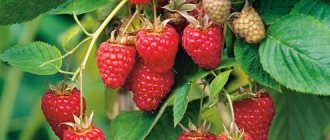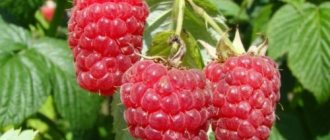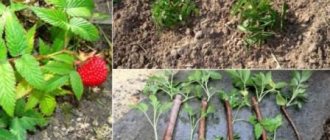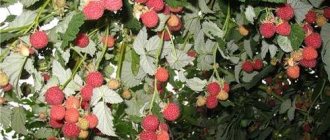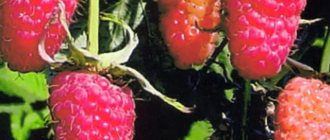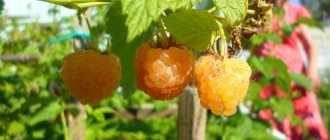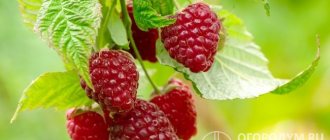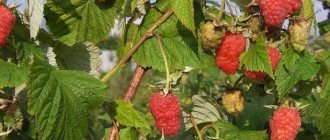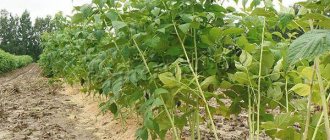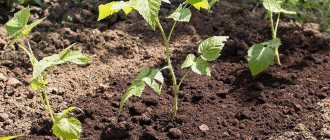Variety selection and its features
Raspberries “Beglyanka” were obtained by the famous domestic breeder Kazakov I.V. and are part of the so-called golden Kazakov series. The variety, characterized by high winter hardiness, after lengthy tests was zoned in the Central region of Russia and today is successfully grown in many regions of the country.
Description of the bushes
Raspberry bushes of the Beglyanka variety are medium-sized and slightly spreading. They take up little space and look very neat near the walls of buildings and fences. During the growth process, the bushes form shoots. So, you can expect 7-9 shoots from each seedling placed on the site. The stems of annual plants are covered with light green skin, the surface of biennial stems is gray with a waxy coating.
Raspberry "Runaway" is prickly. On its shoots you can see short, straight green thorns. They are mainly concentrated in the lower part of the shoots. The leaves of "Buglyanka" are without drooping, green, wrinkled. The edges of the leaflets have medium sharp teeth.
The raspberry variety “Beglyanka” is remontant. Its bushes produce delicious, ripe berries twice a season. The first harvest ripens in the second half of July, the second fruiting period ends in late autumn.
Characteristics of berries
The berries of the Beglyanka variety are very large. The weight of each of them can vary from 2.5 to 5 g. The raspberry pulp is very tender. It has a light, unobtrusive aroma, contains a lot of sugar (7.2%) and some acid (1.6%). The ratio of these substances is harmonious, which determines the wonderful taste of the yellow berries of the Beglyanka variety.
The shape of the raspberries of the proposed variety is round-conical. The color of the berries is golden apricot. Ripe fruits of the Beglyanka variety have an excellent appearance and good marketability. The purpose of the berries is universal, but they are often consumed fresh.
The yield of raspberries of the Beglyanka variety is relatively high and amounts to 700-800 g/m2. In particularly favorable conditions, the yield can exceed the specified figure several times.
Important! Based on the observations of experienced gardeners, it is known that the yield of the Beglyanka variety can reach 2.5 kg from each bush. You can see the “Beglyanka” raspberry harvest, evaluate its external qualities and hear feedback from the farmer by watching the video:
You can see the “Beglyanka” raspberry harvest, evaluate its external qualities and hear feedback from the farmer by watching the video:
This is interesting: Cherry “Pink Pearl” - pollinators, variety description, photo
Bottom line: advantages and disadvantages of the variety
Analyzing the description, photo of the “Beglyanka” raspberry variety and reviews about it, we can talk not only about numerous advantages, but also about some disadvantages of the culture. By correlating the positive and negative qualities of the Beglyanka variety, each gardener will be able to independently draw a conclusion about the rationality of growing this raspberry on his or her plot.
The advantages of the Beglyanka variety are the following qualities:
- excellent appearance of berries;
- high taste qualities of fruits;
- universal purpose of the crop;
- high yield;
- average growth vigor of bushes and evenness of shoots;
- excellent resistance of raspberries to freezing;
- good bush resistance to various diseases.
Along with the listed advantages. Some disadvantages of raspberries should be noted:
- the presence of thorns on the shoots;
- unsuitability of berries for long-term storage and transportation.
Thus, we can say that all of the listed disadvantages are relative and are inherent in most other raspberry varieties.
Raspberry “Beglyanka” is a wonderful variety for novice gardeners and farmers who do not have a lot of energy and time for painstaking care of plants. The bushes of this crop are unpretentious and require minimal care. Raspberry shoots are erect and do not require garter. Plants respond gratefully to the application of fertilizers, increasing their yield significantly. The taste characteristics of the berries are wonderful: raspberries can please every taster with their sweetness and aroma. It is probably due to the combination of high taste and ease of cultivation that the Beglyanka raspberry was awarded such a high position in the general ranking of yellow varieties.
Landing Features
The technology for planting Beglyanka raspberry seedlings is practically no different from planting other varieties. However, when carrying out planting activities, it is necessary to take into account several important factors that influence the further development of the bushes - in particular, the planting site, soil, and humidity.
Deadlines
Planting of seedlings can be done in spring or autumn, depending on the climatic conditions of the growing region. In northern zones, it is recommended to carry out activities in the spring so that over the summer the plant can take root well and adapt to new conditions.
In the southern and central regions, spring planting is practiced. Seedlings are planted in warm, well-warmed soil, the temperature of which should be at least +15°C.
Choosing a suitable location
For the future raspberry garden, it is recommended to choose a well-lit, bright, quiet place, protected from drafts and cold winds. The optimal location of the bushes is the south side of the site, along the fence.
The runaway prefers nutritious, loose and fertile soils with a neutral or weak acidity level. A few weeks before planting the raspberry tree, the soil can be enriched with nutrients - for example, a solution of bird droppings or mullein.
Selection and preparation of planting material
The growth of seedlings, the speed of their rooting, as well as subsequent development will largely depend on the quality of the planting material. Experts advise purchasing raspberry seedlings from nurseries or specialized stores that guarantee the grade of planting material.
When choosing a plant, you need to pay attention to the condition of its root system. The roots must be strong, strong, elastic, without dryness, visible damage, suspicious spots, rot, or signs of disease. Each seedling must have at least 2-3 healthy shoots and 3 buds
After purchasing the material, the root system is dipped in a special mixture and stored in this form until planting.
Each seedling must have at least 2-3 healthy shoots and 3 buds. After purchasing the material, the root system is dipped in a special mixture and stored in this form until planting.
Important! The root shoots must not be allowed to dry out, otherwise the crop will not take root. Before planting a seedling in open soil, its roots are wrapped with damp material.
Planting scheme
The technology for planting Beglyanka raspberry seedlings is traditional and consists of the following stages:
- Dig a hole 60–70 cm in size.
- The bottom of the recess is lined with a layer of drainage made of expanded clay, brick chips, pebbles, etc.
- A layer of nutritious soil is poured onto the drainage layer: soil removed from the pit, mixed with compost or manure and superphosphate.
- A small mound is made from the soil, on which the seedling is placed.
- The root shoots of the plant are carefully straightened, the seedling is covered with soil so that the root collar remains 5-6 cm on the surface.
- After planting, the soil is slightly compacted and moistened with settled, non-cold water.
To retain moisture in the soil and create favorable conditions for seedlings to take root, experts recommend mulching the soil under the bushes with organic materials: straw, sawdust, peat.
Landing
Planting Runaway, like any other raspberry, is not very difficult. The plant takes root better in slightly acidic or neutral soil. The optimal place for raspberries is a sunny area, where there is no wind, and in winter there is a lot of snow. It is worth noting an important fact that it is better not to plant bushes where tomatoes or potatoes grew before, because these plants have similar diseases.
Runaway plant is planted in spring or autumn. In summer, planting is not recommended, because the plant simply won’t take root.
There are two ways to plant raspberries that are suitable for the seasons mentioned.
Planting in holes
Holes are dug in dimensions of 0.5 m x 0.5 m. Raspberry roots are soaked in a mullein solution and lowered into the ground where the planting mixture should be. The top of the hole is filled with fertile soil.
The bushes are planted at a distance of a meter from each other. There is a two-meter gap between the rows. Note that when planting in holes, the root collar must be several centimeters above ground level. After this, you need to water the soil.
Planting in trenches
With this method of planting, it is necessary to dig a trench half a meter deep and wide. The distance between rows here is reduced to one meter, between bushes - to half a meter.
Then the trench is filled with nutrient mixtures for planting. In most cases, it consists of rotted manure and mineral fertilizers. This layer at the bottom of the trench should be about 15-20 centimeters. After this, we mix everything with soil and plant the Runaway.
We water raspberry seedlings. Next, gardeners recommend mulching the soil with humus or peat. However, if the soil is already wet, then you can get by with purely symbolic watering of the holes or trenches.
It is advisable to plant Beglyanka next to calendula or dill. Such a neighborhood will protect the plant from the invasion of unexpected guests - numerous types of pests.
Subtleties of care
Care for yellow raspberries must be of high quality. It is necessary to provide fertilizer, watering, tying and pruning. Only under such conditions will you get a good harvest.
Fertilizer
The time for applying fertilizer depends on how the crop was planted. The trench method is the most popular and implies compliance with the following dimensions: trench width 0.5-0.6 m, and row spacing 1.2-1.6 m.
The density is maintained based on the variety, but not less than 0.4 m, and the seedlings are not deepened. This method of planting delays the application of fertilizing.
If another method is used, then it is worth adding nitrogen, especially in the first couple of years after planting, because it is during this growth period that the plant especially needs nitrogen fertilizers. It is recommended to apply in early spring, but some agronomists divide it into two parts and apply one in the fall.
Most often, urea diluted with water is used. Other elements (phosphorus, potassium, boron, iron, manganese) are added if necessary. You can use manure and ash on your garden plot.
Watering
Yellow raspberries need to be watered abundantly, this promotes the development of powerful rhizomes and the penetration of roots into deeper layers of the soil. Like any other raspberry, without proper rooting, yellow raspberries will grow at high speed and cause a lot of trouble.
In the southern regions of the country, it is recommended to water yellow raspberries at least 6 times during the growing season. In mid-latitudes, 2-4 times are enough. Watering is usually done in furrows or by sprinkling.
Garter
Varieties of yellow raspberries that have a lush bush need a garter, otherwise the plant will scatter in different directions. In the first month of spring, you need to dig in the pillars and stretch the trellis over them. It is advisable to tie the bush in three places: at a level of 1.2 m from the ground and a couple of branches below.
Trimming
Although, through the efforts of breeders, a large number of rather unpretentious varieties of yellow raspberries have been developed, pruning is still a determining factor in increasing yields.
Remontant varieties are pruned almost completely in the fall before frost, and during fruiting, only shoots from which the harvest has already been harvested are removed. This care should not be ignored, since thickening of remontant raspberries leads to a significant reduction in yield.
Shelter for the winter
Yellow raspberry varieties were bred in the southern regions or in the central part of the country, so in these regions there is no need to cover the bushes. High frost resistance allows you to tolerate winter well.
In the northern regions of Siberia, given the more severe winter conditions, it is still worth taking care of covering with dry grass or earth. To do this, the bushes are bent and tied so that their height does not exceed 0.4 m.
Rules of care
Raspberry Runaway does not require significant care from gardeners. The procedure for caring for a crop consists of traditional agrotechnical techniques: watering, fertilizing, pruning.
Important! Since Beglyanka is characterized by average growth rates, pruning of shoots is not done as often as other varieties. In autumn, after the leaves have fallen, it is recommended to do sanitary pruning by removing old, dry, too weak and damaged branches.
- Watering . Raspberries prefer moderate moisture, so under normal weather conditions they are watered 2-3 times a month. In case of prolonged drought, the amount of irrigation is increased to once a week. During rainy summers, the bushes are not moistened at all, or moistened once a month.
- Feeding . Nutrients are applied to raspberries throughout the growing season. In early spring and late autumn, after harvesting the fruits, the bushes are fed with organic means, for example, bird droppings, rotted manure or humus. In the summer, mineral preparations are used to feed the crop: superphosphates, potassium and phosphorus based products. Fertilizers are applied in granular form, or diluted with water and combined with irrigation.
- Weeding and loosening . Immediately after moistening the bushes, it is necessary to loosen the soil, which allows you to saturate the soil with oxygen and nutrients, thereby activating the development of root shoots. Also, 1-2 times a month, weeds are weeded, which inhibit the full growth of the crop.
The best varieties
Be sure to choose the best varieties of delicious yellow raspberries for growing in your summer cottage. After all, today there are quite a large number of them and each variety has certain qualities.
Amber
Known in Russia for more than 30 years. It is practically not exposed to pests, and is also a winter-hardy variety. The yield is about 3 kg per bush, harvested in 5 approaches. Medium late ripening. The berries are not the largest, but not small either, weighing on average 4 g, amber in color, round in shape. Easy to transport.
Fugitive
Bred by the famous Russian breeder I.V. Kazakov. This variety has larger fruits, weighing up to 5 g, in comparison with the previous one, and is classified as early ripening. It tolerates frosty winters well, which makes it possible to successfully grow the crop in Central Russia. Productivity is 2.5-3 kg per bush.
Apricot
Released in 1996. A fairly fruitful variety, characterized by obtaining a harvest already in the year of planting. One of the unpretentious, frost-resistant varieties. The bushes reach a height of up to 1.6 m, slightly spreading. The ability to shoot is average, which will allow for less pruning.
The features include:
- after complete ripening, completely all the berries fall off;
- if the weather is too rainy, the taste of the berries may deteriorate;
- gartering of a raspberry bush is necessary annually;
- may be affected by a viral disease such as “raspberry dwarfism”.
Yellow dessert
This raspberry variety was bred in Russia in the post-war years. This happened at the Gornotaiga Experimental Station. It is classified as an early ripening plant, the yield is on average 2 kg per bush, raspberry berries are small, weighing up to 2 g. The plant usually does not exceed a height of 1.5 m, a rather spreading bush. This variety is classified as non-remontant. The thorns are not sharp.
Yellow giant
This variety is distinguished by its “giant” berry, weighing up to 6 g, the yield is also at a fairly high level - up to 6 kg per bush. Frost resistance is low and requires sheltering of shoots. Medium early ripening. The bushes reach 2.5 m, which requires the installation of supports and tying.
With careful care, signs of remontancy appear, but in this variety the shoots are not completely cut out, because the second year is characterized by the main abundant fruiting.
Golden autumn
The berries are quite large - up to 5-7 g, dense, which ensures good transportability. The yield is average, up to 2.5 kg per bush. Fruits from mid-August to early October. The bushes are medium, no higher than 2 m, spreading is weak. Characterized by high immunity to diseases.
Golden domes
The berries of this variety are characterized by slight sourness, strong pubescence, weight up to 6 g. They tolerate winter cold well, are unpretentious and quite productive - more than 2 kg of fruit per bush. The variety is characterized by low rates of shoot formation. The height of the bushes is up to 1.5 m. It is frost-resistant; one rhizome is left under the snow.
Orange miracle
The fruits of the variety are quite large, reaching 8 g. The species is capricious in drafts, and there is no need to cover the bushes for the winter. Bushes up to 2 m high, grow quite slowly. The berries, even overripe ones, remain on the bush and do not fall off.
By growing this variety, you can not renew the raspberry tree for 15 years, while the main qualities of the variety remain at a high level. The only raspberry variety that allows the berries to ripen on cuttings placed in water. It is because of this quality that the variety is used by florists to create unique bouquets.
Yellow sweet tooth
It has a high yield, exceeding 3 kg per bush. The berries weigh up to 6 g and do not fall off for a long time, which is very pleasant. The bushes are spreading, so gardeners often use wire fencing to form a bush. The disadvantages include the low transportability of the berries and poor frost resistance; you have to cover them additionally.
Yaroslavna (Brusvyana)
The variety was bred by Ukrainian breeders, therefore it is well adapted specifically for the climatic conditions of Ukraine, and in Russia it is recommended for cultivation only in the southern regions. Mid-season variety with an extended fruiting period: from early June to the first frost. Productivity up to 3.5 kg, berry weight up to 9 g. Bush up to 1.7 m high, branches slightly.
Reviews from gardeners
Maxim, Skopin: “I planted 4 fugitive bushes 5 years ago. The variety is not bad. But the berries are a bit sour for my taste. The advantage of this variety is the abundant formation of shoots: during cultivation, the number of bushes increased to 20 pieces. I like the long formation of berries. All summer and early autumn I collect fresh berries for the table.”
Igor, Moscow region: “I love Beglyanka for its bright apricot color. The berries are sweet and sour, although there are few of them on the bushes compared to other varieties. I feed the plants only with organic matter: mullein or chicken droppings. I don’t cover it for the winter.”
Natalya, Makhachkala: “Beglyanka pleases me with tasty and large berries every year, although not many of them ripen on the bushes. But the plus is that the berries ripen constantly - from the end of June to the end of September. Flowers bloom right up to the frost, and it’s even a pity to watch them die.”
5 / 5 ( 1 voice )
The best early raspberry varieties
Early ripening raspberry varieties, depending on the territorial location of your region, may begin to bear fruit as early as the end of May. Moreover, some varieties bear berries for so long that inexperienced gardeners may mistakenly classify them as remontant. The berries of most representatives of this group have very high commercial qualities. However, they also have common disadvantages. For example, most early raspberry varieties are distinguished by a slightly reduced volume of fruiting compared to their “later” colleagues, which does not prevent them from being favorites of private gardeners, but makes them unsuitable for cultivation for the purpose of sale or industrial production.
We present to you our TOP 7 best varieties of early raspberries.
Advantages of the Beglyanka variety
The advantages of the yellow raspberry variety include:
- Great taste and versatility.
- The bushes are compact, not very tall, the thorns are located at the base, which greatly simplifies care and harvesting.
- Increased frost resistance.
- Good disease resistance.
Due to the absence of a coloring pigment, Beglyanka can be consumed by small children, pregnant women and people with allergic reactions.
Description of raspberry Beglyanka
This variety is characterized by medium-sized bushes. The shoots spread slightly throughout the area. Note that Beglyanka’s plants are small in size and there are up to eight of them per bush. In the second year, the shoots acquire a grayish tint and become erect. Annual plants are light green in color. The stems of the Runaway do not have many thorns. They are green in color. The spines are short and thin. They, like the plant itself, acquire a gray color with a brown tint in the second year.
The leaves of this variety are medium-sized, slightly wrinkled and green in color. There is no edge. The leaves are slightly jagged at the edges with sharp ends.
Gardeners call the fruits of the Beglyanka “apricots”. The berries received this name for a reason, because they have a similar golden color. The shape of the fruit is a rounded cone. The flesh of Beglyanka is tender with a sweet and sour aromatic taste. The weight of a ripe berry reaches three grams.
The Beglyanka variety tolerates cold quite well. The same can be said about heat and drought. These raspberries are resistant to most pathogens and pests. Therefore, it is not surprising that Beglyanka is very popular among many gardeners in the country. If all the rules of agricultural technology are observed and the weather is acceptable, the raspberry harvest will exceed 7.5 tons of berries per hectare.
Gardeners often note the undeniable advantages of the Runaway. For example, it is a dietary product. If we compare it with ordinary red raspberries, then Beglyanka contains much less anthocyanins. That is why allergy sufferers prefer this variety. Another advantage of the yellow berry is its optimal combination of acid and sugar. Lovers of home cellars also highly appreciate Beglyanka, thanks to which the jam turns out to be an unusual light color.
Reviews
Igor S: I love this berry for its unusual apricot color! Because of this, I’m even ready to close my eyes for being picky in storage.
Kirill M: If you are tired of ordinary red raspberries, then Beglyanka is made for you. But you should immediately take into account that you will have to tinker with it more. However, the result is worth all the effort!
Anna V: Unfortunately, I have allergies. But thanks to Beglyanka, I can treat myself to raspberries.
Egor P: Excellent variety! Just don’t forget to feed the plant with organic matter in the spring. Personally, I use cow manure.
Harvesting and storage
Beglyanka raspberries begin to ripen in the second half of July, with the fruiting period lasting until October. The fruits do not ripen at the same time, which makes it possible to enjoy tasty and aromatic berries for several months.
Did you know? Raspberries have had the status of a “female berry” for a long time. Among berries, it holds the record for iron content and helps women compensate for monthly blood loss.
Raspberries are picked from the bushes in the early morning or evening, in warm, dry weather. For storage, the berries are picked along with the stalk and placed in a small container of no more than 3-4 tiers. Beglyanka cannot boast of good keeping quality and transportability, and the berries are also not suitable for long-term storage. The shelf life of fruits in the refrigerator is no more than 3–5 days.
Often, yellow raspberries of the described variety are used fresh. It has a rich chemical composition, which is represented by many useful, vital vitamins and minerals that have a beneficial effect on health.
Landing conditions
Yellow Raspberry Runaway is picky about choosing a location. Shaded areas are not suitable for it - then all efforts will be spent on growing green mass, which will damage the harvest. You should choose free space away from other crops, with a sufficient amount of ultraviolet radiation.
The Runaway also doesn’t like the lowlands, where moisture always stagnates. This can lead to root rot. Areas where snow will linger are what you need. But we should not forget about the variety’s dislike for drafts.
Diseases and pests
There are several universal drugs that are used to prevent diseases and parasites. To prevent the development of fungal infections, the bushes are treated with Bordeaux mixture (10 g per 10 liters of water). Nitrafen (20 g per 5 liters of water) is used against bacterial diseases. Prevention against pests consists of regularly loosening the soil, eliminating weeds and spraying with manganese solution (1 tbsp per 10 liters of water). The spraying interval is 2 weeks.
Important! If you notice that signs of diseases or parasites have appeared on the bushes, immediately cut off the affected shoots and leaves. After this, they are burned away from the garden so that the spores do not spread throughout the entire area. If we consider methods of combating common diseases and pests, the following should be highlighted:
If we consider methods of combating common diseases and pests, we should highlight the following:
- Against white spotting, use “Hom” (20 g per 5 liters of water). Treatment is carried out a week before flowering and 14 days after harvesting.
- Treatment of anthracnose involves the use of copper oxychloride (50 g per 10 liters of water) or Topaz (2 ampoules per 3 liters of water). The optimal spraying period is early June.
- Bordeaux mixture is used against rust (100 g per 10 liters of water). The bushes are treated a week after flowering.
- Spraying with Confidor (20 g per 5 liters of water) or Iskra (100 g per 6 liters of water) helps get rid of the raspberry beetle. The bushes are treated a week before the formation of buds.
- Raspberry aphids are eliminated during the period of flowering and bud formation. To do this, use a solution of “Aktara” (2 ampoules per 5 liters of water) or “Confidor” (50 g per 5 liters of water).
Growing the Orange Miracle variety is simple and does not require large financial or time expenditures from the farmer. It is enough to follow all the rules for planting and care to grow high-quality products. Be sure to monitor the condition of the bushes. Only they will indicate which elements are not enough for them.
Growing and care
After proper planting, further competent agricultural technology is the key to consistently high yields for many years. Irregularities in caring for Beglyanka often cause deterioration in the taste of raspberries and their crushing.
Watering
Watering is an important step in the process of caring for raspberries. The remontant variety Beglyanka requires watering once every 7-10 days in dry weather. If it rains and the soil is saturated with moisture to a depth of at least 40 cm, then additional moisture is not required.
If there is a lack of natural precipitation, watering is required before flowering, at the time of active filling of berries, after fruiting and before winter. To increase the efficiency of watering, you should dig a circular trench 15 cm deep around the plant (at a distance of 30 cm from the trunk). Water is poured into it, which will not spread over the soil, but will penetrate directly to the raspberry roots.
Trimming
Pruning of Beglyanka raspberries is carried out in spring and autumn. You should only use a very sharp tool that cuts the shoot evenly without breaking or crushing it. It is important before use, as well as moving from bush to bush, to disinfect the pruning shears in a weak solution of manganese.
In the spring, all shoots damaged during wintering are cut off. If only their tops are frozen, then the shoot should be shortened to the first healthy bud.
In the fall, all non-lignified green shoots, diseased branches, as well as those left over from the previous season are cut off (they will no longer bear fruit). They should be cut off at the root. Thus, only woody shoots of the current season should remain on the plant for wintering, which do not show signs of any diseases or pest damage.
Pests and diseases
Yellow raspberries are quite resistant to diseases and pests; below is a description of some harmful insects to which they can still be attacked.
Raspberry stem gall midge
Lays eggs under the bark of shoots, forming swellings, so-called galls. Larvae develop and overwinter in the galls, which at the beginning of next summer turn into an adult insect that looks like a small black mosquito. Shoots affected by gall midges must be cut off and burned.
Raspberry stem gall midge is especially harmful for remontant varieties, as it significantly reduces repeated autumn fruiting
Raspberry shoot aphid
A small light green insect, no more than 2.5 mm in size.
Lives in colonies near inflorescences and young apical shoots. If this aphid has settled on a raspberry, the growth of the bush slows down, the leaves curl, and the inflorescences fall off.
Ladybugs are good at exterminating aphids; to attract them, pyramids of leaves, stems, and branches are formed in sunny places in the garden, and a piece of plastic film or other waterproof material is secured on top to protect them from precipitation. You can also spray raspberries with infusion of tobacco, garlic, and onion.
Raspberry moth
The insect is not found in gardens as often as the previous ones. Raspberry plantings located close to the forest are at risk. Externally, the gall wasp is similar to a black wasp, without the characteristic yellow stripes. The larvae, like those of the gall midge, develop in growths on the shoots. Damaged stems are removed and burned, and the bushes are treated with insecticides.
The danger to the shrub is not the flying insect, but the larvae of the raspberry gallworm
Raspberry-strawberry weevil
A black bug about 3 mm in size, with an elongated head and an elongated proboscis. It lays eggs in the buds and gnaws the stalks so that the flower falls to the ground and the larva crawls out. The adult insect feeds on young leaves.
Due to the massive fall of buds, the berries are not set, and the yield is significantly reduced.
To repel weevils, you can plant onions and garlic next to raspberries.
Some diseases also affect raspberries.
Raspberry chlorosis
With this disease, raspberry leaves turn yellow and photosynthesis processes slow down. The infection is viral in nature and is transmitted through insect pests and through contaminated planting material. Raspberries stop bearing fruit, the berries become smaller and dry out.
There is non-infectious chlorosis, it is much easier to treat. The cause of the disease is a lack of any substances. For example, phosphorus, potassium, magnesium or iron. Proper feeding and care help the plant heal.
Chlorosis on raspberries - sudden yellowing of leaves at the height of the season
Rust
This is a fungal disease of yellow raspberries; it can be recognized by the appearance of raised yellowish-orange spots on the outside of the leaves and gray sores on young shoots.
Then, convex orange spots form on the underside of the plate, which turn brown over time. Infected leaves are torn off and burned, and raspberries are treated with fungicides.
To prevent the disease, you need to ensure good ventilation of the raspberry plant, avoid waterlogging, thickening and abuse of fertilizers containing nitrogen.
Purple spot
The disease, caused by the fungus Didymella applanata, is spread by wind, rain, and insects. Affects weak, depleted plants. Purple spots and cracks form on the stems, shoots die, and the tops dry out. Brown spots appear on the leaves. The development of the disease is facilitated by high humidity, dense thickets, and the presence of insect pests.
Timely pruning and thinning, mulching the tree trunk area, and using trellises will significantly reduce the risk of purple spot development. For additional protection, raspberries are treated with biofungicides.
Features of care
For yellow Beglyanka raspberries, planting and care are identical to the standard rules of agricultural technology for most representatives of the crop. If you already have experience growing berry bushes, then this variety will not be difficult to cope with. In addition, the Runaway can hardly be called capricious.
Key points of agricultural technology:
- Regular watering should not be ignored - it is carried out once a month. But if the weather is too hot, then it is better to increase the frequency of irrigation so that the berries do not fall off;
- Periodic watering is combined with fertilizing. In addition to the fertilizers that were added to the hole during planting, organic matter is also used at the first stage of the growing season - before the fruits ripen. Then they switch to the potassium-phosphorus complex, necessary to obtain high-quality berries;
- Since the bush is medium-sized, and its branches do not bend under the weight of the fruit, the plant does not need a trellis. At the same time, even small sharp spines on the stems do not interfere with harvesting;
- Beglyanka is pruned twice a year. In the fall, the biennial shoots that have fertilized are removed, and the damaged ones are also cut out. This event is carried out after complete leaf fall and the end of the harvest. In the spring, after the bush opens, the plant is inspected. If frozen or diseased stems are found, they should be cut off.
Other measures are also standard - loosening the soil after watering, removing weeds, mulching. The propagation of Beglyanka is no different from other varieties, which is carried out by seedlings, layering and cuttings.
Pest Control
Gardeners don't have to worry about the diseases that plague most other raspberry bushes. Preventive measures against pests should be taken:
- with the onset of spring and before flowering, plants are treated with preparations such as “Condiforma” or “Iskra”; spraying is carried out in weak sun (at the beginning of sunrise or before sunset);
- throughout the summer and autumn, you can treat raspberry bushes with folk remedies - infusions of garlic, onions, capsicum, tobacco dust; tansy, yarrow, and dandelion also have a deterrent effect;
- in the fall, remove all fallen leaves around the bushes - insects may remain in them for the winter, which can harm the plant next year;
- it is necessary to carry out timely cutting of damaged and diseased shoots;
- for prevention, it is recommended to plant dill, mustard, black root or calendula next to the raspberry tree - they will repel pests;
- It is also worth periodically shaking the branches of the plant during the budding period in order to get rid of parasites that have settled on the bush; insects are collected on polyethylene spread under the raspberries to be destroyed later.
Note! It is not recommended to plant the fugitive near other varieties that are weakly resistant to diseases. With poor agricultural practices, the infection can spread to this variety.
Ready for winter
The shrub is able to withstand frosts, but for this you will have to do a lot of preparatory work:
- at the end of August, phosphorus-potassium fertilizers are applied to the raspberries - this will provide the roots with winter comfort;
- start autumn pruning of bushes at the end of October; in addition to biennial shoots, it is worth removing weak young stems that will not be able to survive the winter;
- the remaining branches are shortened by 20 cm;
- if there are leaves left on the shoots, they should be completely removed to avoid rotting of future buds;
- then each bush is well charged with water - this will protect the roots from freezing;
- the ground around the plants is mulched with a layer of 10 cm to retain moisture; besides, mulch is an excellent “blanket” for roots;
- The stems bent to the soil should be secured with pins.
The level to which the raspberry branches are lowered should not be higher than 0.4 m so that the fallen snow completely covers the plant. Beglyanka does not need additional protection if frosts below -35 degrees are not expected.
The varietal berry garden with its nutritious, tasty fruits is a godsend for real gourmets. But beginning summer residents will especially appreciate Beglyanka for its unpretentiousness to agricultural technology. Raspberries do not require constant attention, but this does not affect the taste of the berries.
The compactness of the bush eliminates the need to build trellises on the site, which also attracts novice gardeners. The poor transportability of the fruit does not scare them away - raspberries are excellent not only in fresh form, but also in processing and freezing.
Description of the variety
Raspberry Beglyanka forms medium-sized bushes that grow up to 110-130 cm, have no more than 8 shoots, and are not spreading. The stems of this raspberry are erect, requiring tying during the fruiting period, since otherwise, under the weight of the crop, there is a risk of their breakage. The spines are few, green in color, and quite hard. If harvested carelessly, they can cause injury. Raspberry leaves are medium in size and bright green in color.
You might be interested! Description of the remontant large-fruited raspberry variety Hercules. Weight of berries up to 15 g!
Beglyanka berries weigh up to 2.6 g and have a golden yellow or deep orange color. The shape of the fruit is round. The taste is high. The berries are sweet, with a slight sourness. The appearance of the Beglyanka raspberry, due to the yellow color of the fruit, is different from most other varieties; it looks very beautiful, but the transportability of the berries is low.
The variety is resistant to major raspberry diseases and frost, so it is suitable for cultivation in most parts of the country.
Like all raspberry varieties, Beglyanka has its strengths and weaknesses.
Advantages of the variety
- high taste qualities both fresh and cooked;
- beautiful appearance of yellow berries;
- versatility of use;
- average height of bushes, simplifying harvesting;
- high winter hardiness;
- resistance to major fungal diseases and pests.
Disadvantages of the variety
- low transportability;
- the presence of thorns;
- the need for tying.
If you do not need to transport or store the berries for a long time, then the variety can be safely planted on your own plot.
Proper planting of raspberries will largely determine its further fruiting. Also, the quality of the resulting berries depends on how good the place is chosen for the raspberry garden. When the Runaway lacks light, its harvest turns out to be meager and with a pronounced acidity in the taste.
You might be interested! Description of one of the best raspberry hybrids with half a century of history - Maroseyka raspberry.
The site for the Beglyanka variety needs to be sunny, dry and not windy. The ideal place for this raspberry is the sunny side along a dense fence or near buildings, where the walls can protect the plants from the wind without shading them.
The optimal time for planting Beglyanka is spring, when the soil has already warmed up and its temperature will be at least 15 degrees. Raspberry seedlings planted at this time have time to get stronger by autumn and develop a sufficient root system to survive the winter well. Also, when planting in spring, it is possible to get a good harvest the very next season.
Holes for bushes are required with a diameter of 70 cm and a depth of 60 cm. The soil remaining after digging is mixed with humus in a 1:1 ratio. A mound is formed from part of this soil at the bottom of the pit. A seedling is placed on it, the roots of which are distributed along the slopes
Then they are covered, paying attention so that they do not bend upward. When planting, the root collar of the seedling should not be buried in the ground.
The soil around the plant is compacted, after which abundant watering is carried out. You should dig a peg near the seedling, to which it will be convenient to tie it in the future.
Features of reproduction
Like all varieties, Beglyanka raspberry propagates: by seeds, cuttings, apical layering and dividing the bush.
The most commonly used method for propagation is cuttings. This method allows you to get the largest number of seedlings from the mother bush. To do this, in the fall, after the last harvest, the required number of cuttings + 20% are cut from the mother plant (in case not all cuttings take root). Store the cuttings in a box with peat, covered with damp moss. In early spring, seedlings are planted in shkolki, watered and covered with film. By autumn or next year, young plants are planted in a permanent place. With this technique, raspberries take root well.
Reproduction of the Runaway by layering involves bending the tops of the shoots to the ground, securing them with staples and covering them with soil. In spring, a young bush with roots is separated from the mother plant. Raspberries are planted in a permanent place, and the root circle must be mulched.
When dividing a bush, everything is quite simple. In autumn or early spring, they dig up a bush, divide it into several parts, in which there should be at least 1-2 shoots, plant it and water it. In this case, raspberries give a good harvest already in the year of planting.
Choosing a location and preparing the soil for raspberries
The area for planting raspberries should be well lit and protected from the wind. The most successful planting of seedlings is along a fence or wall of a house on the south side. In this case, the bushes will receive enough light in the summer, the fences will protect the bushes from the wind, and trap snow in the winter.
If the site is located on a slope, it is worth dedicating its middle part to raspberries, since in the lowlands the bushes may freeze in the winter, or you will have to deal with waterlogging of the soil in the spring, during meltwater.
Crop rotation rules for raspberries
- Precursors such as tomatoes, potatoes, and strawberries are undesirable for raspberries. It is also best to avoid the proximity of these crops to raspberries.
- Raspberry root secretions help protect apple and pear trees from a fungal disease - scab, and the apple tree can save raspberries from gray rot.
- You can avoid the overgrowth of raspberries by limiting planting to sorrel. Two or three rows of casing along the contour will increase the acidity of the soil, and the roots will not grow in this direction.
- With proper soil preparation, berry bushes can grow for 10-15 years in one place.
Soil preparation
Raspberries love fertile, light and well-drained soil. To grow it on sandy and peat soils, it is necessary to annually add humus and compost to stimulate the activity of microorganisms.
Heavy clay soils are not suitable for growing raspberries, as the roots will rot. The acidity of the soil under the raspberry tree should be neutral or slightly acidic.
The soil for the raspberry plant is prepared in advance by digging deeply and applying organic and mineral fertilizers. For autumn planting - at least a month in advance, for spring planting - from autumn. As fertilizers, manure or humus is added, urea or ammonium nitrate, superphosphate and potassium salt are added.
Yellow raspberry varieties: "Amber"
If you translate the name of this variety into Russian, you get amber. You can understand the people who gave it this name: from afar, the fruits look as if they were made of amber. The fruits have a stunning appearance, fresh aroma and sweet taste; the variety is considered a dessert variety.
This plant belongs to the group of varieties with late ripeness, does not have large berries, but has a high level of resistance to various diseases and cold, which means there is no need to rack your brains and think about winter protection.
Usually bears berries from the last week of the second summer month to the first autumn month. Shrubs grow up to two hundred to two hundred and fifty centimeters. Basically, pods have a mass of three to four grams. Inside, the berry is sweet and without voids; its density is rated at three and a half points on a five-point system. The specificity of the plant includes its high levels of resistance to various diseases and parasites.
Description
“Golden Autumn” is a variety of remontant large-fruited raspberries. Each berry weighs on average about 4-5 g, individual specimens weigh up to 7 g. The shape is cone-shaped. The drupes are tightly fastened together. Thanks to this, berries can be transported over long distances.
The fruits not only look decorative, they taste like desserts. Juicy, sweet, with a rich raspberry aroma - every member of your family will like these berries. They can be consumed both fresh and after heat treatment, for example in jams. The preparations look very exotic due to the golden color of the fruits.
The first harvest in central Russia ripens by the second half of August. Continuous fruiting continues until the onset of permanent frosts.
The variety is winter-hardy and suitable for cultivation even in the northern regions of our country. In this case, young bushes must be planted on the south side of the buildings. Thus, they will be maximally illuminated by the sun and protected from open winds.
To get good results, it is very important to properly prepare the soil. Raspberries prefer loose, fertile soils with low acidity levels. Care should focus on regular watering and loosening, periodic fertilizing and pruning.
With proper care, the height of the bushes can reach 1.5 m
Care should focus on regular watering and loosening, periodic feeding and pruning. With proper care, the height of the bushes can reach 1.5 m.
Characteristics, description
Beglyanka forms medium-spreading bushes with an average growth rate, on which 6–8 shoots are formed per season. Annual shoots are straight, light green in color, with slight pubescence and a slight waxy coating on the surface.
Biennial branches are erect, gray in color. The culture has virtually no thorns. Its branches are covered with sparse green, but rather hard thorns, the main part of which is concentrated at the base of the branches. The green mass of the plant is represented by medium-sized green leaves, with a wrinkled structure, without pubescence, with small notches along the edges of the plate.
The variety belongs to the category of remontant, early ripening, whose berries can be harvested twice per season. The first berries ripen in the second half of July. The second wave of fruiting continues until late autumn. During the flowering period, white flowers, no more than 1 cm in diameter, appear on the bushes, which emit a pleasant honey aroma.
Raspberry berries are quite large, weighing 3–5 g, round-conical in shape, very beautiful yellow-apricot color . The pulp is fragile, very tender, has a sweet taste with a slight hint of acid and a delicate, subtle raspberry aroma. The berries contain up to 7.2% sugar and about 1.5% acid. The fruits have an excellent presentation, but due to their soft structure they do not tolerate transportation and storage well. As a rule, raspberries are used fresh.
Did you know? Along with the traditional yellow or red, there are purple raspberries. This unusual berry is the result of crossing ordinary raspberries with blackberries.
Raspberry News Kuzmina
This early ripening raspberry belongs to the varieties of the oldest domestic selection - it was bred, you won’t believe it, back in the 1880s in the Nizhny Novgorod region! And to this day, Novosti Kuzmina is one of the most widespread and beloved varieties in our country.
| Kuzmina News |
| Forms an erect, semi-spreading bush up to 2-2.5 m high with an average number of slightly thorny shoots covered with a grayish waxy coating. The flowers are large and white. The leaves are medium-sized, dark green, slightly wrinkled, with soft, few miniature spines on the lower surface. The variety has a high level of self-fertility. Fruiting time is about 50 days. Productivity – up to 1.5 kg per bush (50-60 c/ha). |
| Ripening period: medium-early. In the middle zone it begins to actively bear fruit in mid-June. Fruits: weighing 2-4 g, crimson, matte, blunt-conical in shape, with long stalks, with a weak aroma. The taste is excellent – “classic raspberry”, sweet with a sour-sweet aftertaste. The pulp is juicy and separates well from the stalk. Features of cultivation: the variety is very unpretentious and hardy, extremely winter-hardy. This raspberry is not picky about soil, although it prefers fertile sunny areas, protected from cold drafts. Pinching of young shoots and gartering are necessary. The main requirement for care is regular, abundant watering, without which the berries will dramatically shrink. The variety is poorly tolerant to fungal and viral infections and pests, but the berries have time to ripen even with noticeable damage to the bushes. The berry is poorly transportable and cannot boast of high keeping quality. |
The secret is in care
“AiF”: — Raspberry is a rather aggressive plant. Are there varieties that do not spread?
| Interesting |
| Raspberries were previously grown to collect leaves and flowers. Tea made from dried flowers, ovaries, and buds is very useful in the fight against winter ailments. Brilliantovaya and other autumn varieties, in which not all the berries have time to ripen, are good for this purpose. |
E.Ya.: – Indeed, raspberries are aggressive. But different varieties behave differently. For example, the Bulgarian variety Kostenbrodskaya spreads very far. The bush is uprooted, and the shoots are gone! – and jumps out at a distance of 2 meters.
But this quality of raspberries can be used. Once a raspberry snuck into my cucumber greenhouse. Now, every year I leave 2-3 raspberry shoots at the northern end of the greenhouse. The harvest ripens in early June. If you take an early variety, for example, Meteor, then the berries may be even earlier. Or you can plant autumn varieties instead of summer varieties. For example, the Penguin variety is small in stature and will not bother anyone, but, of course, you will need to monitor the root system.
“AiF”: — I heard from gardeners: “I uprooted the raspberries and won’t grow them again!” It doesn’t grow here!” Raspberries are disappearing from old plots because people don’t see the return.
E.Ya.: – Why do they say “raspberry culture”? Because it should not be treated like a weed. In one place, raspberries can live up to 12–15 years. More, only if you carefully look after it - fertilize, loosen, weed. Over time, the bushes degenerate - the rhizomes age, pathogens and pests penetrate into the wounds. The plantings need to be updated. Immediately uproot any bushes affected by the growth.
Protection from pests is also required. Of course, the worst thing is the raspberry beetle: if it is already infested, then the whole berry will be wormy. But chemical treatments can only be carried out before the buds open. It is also useful to destroy weeds on which the beetle feeds in the spring.
Yellow-fruited raspberries “Yellow Giant” and “Runaway” (with photo and description)
Check out the photo and description of the “Yellow Giant” and “Runaway” raspberries - the most common in the middle zone.
Raspberries of the Beglyanka variety are very popular among amateur gardeners. The raspberry bush is medium-sized (1.7-2.0 m), slightly spreading, the shoots are erect, almost thornless, the shoot productivity is good (7-9 pieces per bush). It is distinguished by its high winter hardiness. The yield is good - up to 2 kg of berries per bush. The berries of the yellow-fruited raspberry “Beglyanka” are medium-sized (2.5-3 g), golden-apricot in color, excellent taste with a delicate aroma, not transportable.
“Yellow Giant” is the first large-fruited, highly productive variety of yellow raspberries. According to its description, the “Yellow Giant” raspberry is similar to the “Beglyanka” variety, but its berries are much larger (5-12 g), blunt-conical, with an amber shiny surface, dessert type, juicy and very sweet, with an excellent wild raspberry taste. This is a plant with a mid-early ripening period (from July 8-10 to early August). Productivity is very high (5-12 kg per bush). Increased resistance to disease.
Flaws
The main disadvantages include:
- The fruits are beautiful, but do not tolerate transportation well, so they are grown for personal consumption or in small batches to sell quickly locally.
- Presence of thorns.
- Average yield.
Time and place of planting Beglyanka in open ground
It is better to plant the variety in the spring (March-April), depending on the region, so that the plant has time to take root before the heat begins; in the southern regions, autumn plantings are preferable (October).
Choose a sunny, windless place, preferably near a fence or on a slight hill. The heat-loving berry does not tolerate shading or drafts.
The soil is preferable to neutral acidity, but it is also possible to grow on slightly acidic soils. In case of high acidity, it is necessary to add dolomite flour or ordinary lime.
Volnitsa raspberry variety, characteristics, advantages, planting and care
Specialists from GNU VSTISP, who set the goal of obtaining frost-resistant raspberries for cultivation throughout Russia, crossed “Bryansk” raspberries with the “Brigantina” variety and achieved the desired result. The new variety was called “volnitsa”. It quickly spread and became popular. Now the description of the raspberry variety Volnitsa is included in the catalogs of all stores selling planting material.
Description of the variety
The bushes are tall (up to 200 cm), spreading, that is, they need to be tied to supports. The construction of a trellis along the raspberry tree solves this problem. During the season, up to 5-6 young shoots develop.
They are light green, and two- or three-year-old shoots are light brown, erect, covered along their entire length with a light waxy coating and dotted with dark red thorns, not very large and not too sharp.
The bush produces more than ten fruit branches strewn with large berries. The leaves are densely green, not pubescent, wrinkled and slightly curled.
Volnitsa raspberry bushes
The variety is characterized by high resistance to pests and traditional crop diseases.
Productivity and ripening time
Raspberries feel free in regions with different climatic conditions, perhaps that is why they called them “freedom”. In Ukraine, Belarus, and southern Russia, the variety begins to bear fruit by the end of June, which makes it possible to classify it as a mid-early variety. In the rest of the territory, in terms of ripening time, the raspberry variety “Volnitsa” is considered mid-season.
The yield from one “volnitsa” bush reaches 4 kg - the result is not outstanding, but quite satisfactory for the needs of an ordinary summer resident. Moreover, the quality of the berries, according to reviews from fans of the variety, is simply excellent. Weighing up to 5 g, they adhere firmly to the bush, do not crumble, do not cake, and are transportable.
Ripe raspberries of the Volnitsa variety
The aroma of the berries is subtle, unsaturated, pleasant - the traditional smell of raspberries. The acids and sugars in the berries are divided in half (8.9% each), which made it possible to receive ratings of at least 4 points in terms of taste. The purpose of the fruit is universal: good fresh and for any preservation.
Advantages and disadvantages
Having become interested in the characteristics of the variety, fans of the culture carefully study the description of the raspberry variety Volnitsa in order to weigh all the pros and cons. Having put together the initial criteria of breeders, reviews of gardeners growing “freedom”, we get the following breakdown.
The advantages of the variety include the following indicators:
- frost resistance is high, does not require shelter down to -35°C;
- shoot formation is moderate, which is good for growing bushes: excessive thickening during the season does not threaten the raspberry tree;
- quality and quantity of harvest;
- when ripe it does not fall off the bush - minimum losses;
- resistant to attack by the raspberry beetle (wormy berries are practically never found), and raspberry stem fly;
- resistance to pathogens of fungal diseases;
- transportability, universal purpose of fruits.
Raspberry bushes with trellises
Among the shortcomings are the following:
- it is necessary to equip the raspberry garden with trellises;
- low shoot formation is considered a disadvantage by those who need to quickly propagate raspberries by root suckers (for example, to sell planting material);
- berries that sit firmly on the stalk are difficult to remove from the bush;
- presence of thorns.
As you can see, the variety has many more advantages, and some disadvantages (firmly seated berries and moderate shoot formation) can be considered as advantages - it all depends on the gardener’s goals.
Features of cultivation
Planting, caring for and growing Volnitsa raspberries in the main points is not much different from those for classic varieties of berry bushes. Therefore, it will not be difficult for an experienced gardener to achieve excellent results, but a beginner can easily master the crop by following all the recommendations.
Selecting a location
Any berry crop requires a lot of light, sun, and heat. Raspberries are no exception. Traditionally, raspberries are planted along the fence on the sunny side: additional support, protection from wind and drafts.
Raspberry bushes near the fence
Before planting a raspberry tree, you should make sure that the groundwater is deep enough, otherwise there is a risk of soil being washed out or the roots freezing out.
The place for the raspberry tree needs to be dug up well, cleared of weeds, and compost or humus added: raspberries love light, fertile soil. Too heavy clay soil must be diluted with sand and peat. The site is prepared for planting in advance. A site fully prepared in the fall for spring planting is an ideal option.
Preparation of seedlings
Seedlings also require preparation before planting. First of all, all shoots are shortened to 40 cm. After examining the root system, make sure that the roots are intact, elastic, and healthy.
Remove damaged fragments with a sharp knife. Soak the roots of the seedling for 20-30 minutes in a weak (light pink) solution of potassium permanganate or use a fungicide according to the instructions.
Before lowering such seedlings into the ground, sprinkle the cuts with crushed coal.
Planting raspberry cuttings
Treatment with a root formation stimulator would not be superfluous. Seedlings with a healthy root system are soaked in “Kornevin”, “Heteroauxin” or another preparation with a similar effect according to the instructions. If the roots are treated with fungicide and crushed coal, then it is enough to dust the root system with root stimulator powder before lowering the seedling into the ground.
They plant the “freemen” in separate holes every half meter in a row or in trenches with the same distance between the bushes.
When planting using the first method, a high stake is immediately stuck into the center of the hole for subsequent tying up of long shoots. It is convenient when it is a stake with several crossbars at different heights.
When planting in trenches, it is easier to organize a trellis - stakes at a distance of 1.5 - 2 m with wire stretched at different heights.
Watering and fertilizing
The peculiarities of watering when growing “Volnitsa” raspberries are to constantly monitor the level of soil moisture. It should not be too dry, but flooding the soil is unacceptable. In the spring, raspberries are watered if the winter turns out to be little snowy.
Particular attention to watering raspberries when the bushes begin to bloom and set fruit. But the berries, filling with juice and color, do not require moistening the bushes, otherwise the quality of the harvest will suffer. The last watering, moisture recharging, is carried out in preparation for winter.
Feeding raspberry bushes
In any case, take into account the amount of precipitation: excessive moisture is dangerous due to rotting of the root system and subsequent death of the bushes. To preserve moisture, the ground around the bushes is periodically loosened, all weeds are removed, after which the tree trunk circles are mulched with peat, compost, and cut grass.
To feed raspberries in the spring, fertilizers containing nitrogen are applied: it stimulates the growth of green mass. Adherents of organic farming use bird droppings and rotted manure for this purpose. The second feeding occurs at the beginning of flowering. For more abundant fruit formation, potassium (wood ash) and phosphorus (bone meal) are needed.
Trimming
A prerequisite for a healthy raspberry tree is pruning, which is carried out throughout the season:
- In the spring, when inspecting the bushes, all broken, frozen shoots are cut off. If the damage affects only the upper part of the shoot, the cut is made above the first living bud. With a deep degree of damage, the shoot is completely removed.
- In the spring, only strong, strong shoots are selected for the upcoming season, and weak, thin shoots are cut out at the root so that the bush does not waste energy on unpromising shoots.
- In the summer, from time to time inspecting the bushes, you should remove dry, damaged leaves, inflorescences, and berries to prevent the spread of infection.
- By winter, those shoots from which the harvest has been harvested are completely cut out. When pruning, do not leave stumps above ground level: over time, they will become a breeding ground for pests and diseases.
Preparing for winter
Sanitary pruning and moisture-replenishing winter watering (if the autumn was dry) are the main measures to prepare Volnitsa raspberries for winter.
https://www.youtube.com/watch?v=ge_pq7ct4Sg
Preparing raspberry bushes for winter
In regions with particularly harsh winters, it is recommended to tie young flexible shoots, bend them to the ground, cover them with non-woven fabric, spruce branches, and cover them with leaves or peat.
Diseases and pests
Compliance with growing conditions in all respects is the basis for the health of the “Volnitsa” raspberry; its advantage—high resistance to diseases and pests—is indicated in the description of the variety.
But inclement weather can be a provocation for problems: in a cold, damp summer, even a strong immune system cannot save you.
To protect berry bushes and increase resistance under stressful conditions, it is recommended to treat fruit crops with Bordeaux mixture in spring and autumn.
Pests traditional for raspberries - the worm (the larva of the raspberry beetle), the raspberry weevil - attack varieties that bloom earlier.
The gall midge overcomes shoots with a damaged surface layer, since it penetrates into the stem through wounds, cracks, and breaks. Timely sanitary pruning will prevent the spread of the pest.
A waxy coating on healthy shoots protects the plant from pests and infectious diseases.
Volnitsa raspberry harvest
Volnitsa raspberry is an excellent variety that combines a lot of advantages with ease of care. The work of domestic breeders is appreciated by summer residents from all regions of Russia.
Source: https://vosaduly.ru/articles/malina-volnica-opisanie-sorta.html
